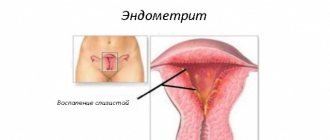Can menstruation be delayed after a cervical biopsy |
A biopsy is a mini-surgical operation. It does not bring severe painful sensations, but during its implementation minor trauma to the functional layer of the uterus occurs. After the biopsy, the woman experiences spotting. In some cases, the procedure affects the nature of menstruation.
What is a biopsy
The invasive intervention is a simple gynecological operation performed on an outpatient or inpatient basis. The purpose of a biopsy is to collect cells and pieces of tissue intravitally for microscopic examination to determine the nature of the pathology.
Such a surgical intervention does not exclude the occurrence of various complications after the procedure. Before the analysis, the woman should be informed in detail about all possible consequences. Discharge after a cervical biopsy and slight bleeding in the first days should not disturb the patient. These symptoms are always present after such a diagnosis.
Pipel, aspiration and CG biopsy of the endometrium - what is the difference?
Endometrial biopsy is one of the most important diagnostic methods in gynecology. This procedure is necessary for further microscopic examination of the obtained tissue samples, which makes it possible to determine the existing morphological changes in the uterine mucosa.
Currently, several types of endometrial biopsy are used, each of which has its own purposes, indications and diagnostic capabilities.
Endometrial biopsy: what is it?
An endometrial biopsy is an intravital sampling of tissue from the lining of the uterus (endometrium) for subsequent histological and histochemical analysis.
This procedure refers to minor surgical interventions in gynecology and is most often performed as an independent study.
But in some cases it is included in the protocol of a “major” operation and is performed intraoperatively on an emergency basis.
A biopsy most often serves purely diagnostic purposes. But in some cases, it is a therapeutic and diagnostic manipulation that allows you to obtain the information the doctor needs and at the same time improve the woman’s condition. The preparation process, the extent of the intervention, and whether the woman will be in pain or not also depend on the type of biopsy used.
Types of research
The first documented collection of a sample of the uterine lining for analysis was performed in 1937 by Butlett and Rock. In this case, special instruments were used to dilate the cervix and scrape out (mechanically separate) the entire endometrium.
The main objective of this study was to determine the severity of cyclic changes in tissues caused by the hormonal background of a woman. Subsequently, the indications for biopsy expanded significantly, and the method itself began to be improved. This allowed
Source
Features of the procedure
Of course, every woman before a biopsy worries about possible complications. A competent doctor should explain the reasons for the invasive intervention, talk about the course of the operation and the resulting consequences. Brown discharge after a cervical biopsy may persist for several days.
Immediately after completion of medical procedures, the patient is given recommendations to help quickly recover from the diagnosis.
Indications for the procedure
The main task of a biopsy is to identify the presence of atypical pathological cells in the tissues of an organ. The following deviations may be the reason for ordering an analysis:
An invasive diagnostic method is carried out in the first period of the cycle, 3-6 days after the end of menstruation. It is forbidden to do a biopsy at the time of maturation of the corpus luteum. In this case, the woman’s body will not have time to recover by the beginning of the next cycle.
The gynecological procedure itself lasts no more than half an hour under general or local anesthesia. Most often it is done on an outpatient basis. After the procedure, the patient needs to rest for 20–40 minutes, then she can go home.
In some cases, when it is necessary to take a large piece of tissue for analysis, the woman may be asked to go to the hospital for several days.
If the patient has had a cervical biopsy in the past and is planning a pregnancy, it is necessary to warn her doctor about this.
How many days can a period be late?
To track the menstrual cycle, a woman needs to know how long the norm for a missed period may be. This will allow you to promptly notice the onset of pregnancy or promptly contact a specialist if there are any deviations.
Gynecologists consider 5–7 days an acceptable figure. Above this, a delay in menstruation may indicate pathology in a woman’s body. If menstruation does not come for 3 to 6 months with a negative pregnancy test, then the development of amenorrhea can be suspected.
Contraindications
Despite the fact that a biopsy is a simple and fairly quick procedure that does not require extensive invasive intervention, there are some contraindications to its implementation:
Chronic inflammatory process of the pelvic organs. Violation of the hemocoagulation system. Pregnancy period. Various infectious diseases that can significantly distort the analysis results. Hormonal disorders. Weakened immunity.
Before performing a biopsy, the doctor must prescribe preliminary blood tests. When various pathologies are identified, their treatment will first be required. Invasive diagnosis is possible only after some time.
Failure to comply with these requirements can lead to the fact that the discharge after cervical invasion becomes intense and various complications develop. The woman will need medical attention.
Consequences of the procedure
Typically, patients notice discharge after a cervical biopsy. Is this the norm? As a rule, this is a fairly common phenomenon and should be treated not as a pathology, but as a healing process.
The discharge may vary in color and intensity and continue until the next menstruation. There is no need to worry too much about this.
Usually after a cervical biopsy the discharge is bloody. In this case, the patient notes a slight nagging painful sensation in the lower abdomen. According to doctors, this can last 5-10 days. As the tissues heal, the discharge becomes more scanty. After menstruation, the cervix is completely cleared and bleeding stops.
It is not uncommon for a patient to notice yellow discharge after a cervical biopsy. This is also normal and does not require seeing a doctor.
If the bleeding becomes profuse and becomes threatening, we can talk about the development of a complication such as bleeding. It is necessary to immediately contact a gynecologist if you have the following ailments:
The discharge is not very intense, but lasts more than 3 weeks. Severe bleeding of a bright color appeared. The temperature rose to 38 °C. The discharge has acquired a foul odor.
Such symptoms indicate the development of an infection and require immediate medical attention. The doctor must identify the cause of the complication and prescribe treatment.
My period started earlier after a cervical biopsy | | Medic Help
Strong experiences in girls cause discharge after a cervical biopsy. Bleeding may occur for some time after the procedure. How serious are these manifestations, is it necessary to worry about this, what is the norm - we will consider all the questions in detail.
Source: https://g-women.ru/mesyachnye/zaderzhka-posle-biopsii-2.html
Impact on the arrival of menstruation
During the biopsy, the endometrium is damaged. Therefore, in the first days after the procedure, the woman has bleeding. They end in 2-3 days. The arrival of the next period depends on what day of the cycle the biopsy was performed. Typically, menstruation begins 21-28 days after surgery, as it is usually done in the first half of the cycle.
Uterine cancer. Cycle length. . We recommend reading the article about menstrual irregularities after cervical biopsy.
Menstruation after biopsy. Cervical dysplasia: treatment with traditional methods. . What is possible/not possible. Quantity/allocations. Cycle disruption. Pads/tampons.
Ectropion is a violation of the anatomy of the cervix, its inversion outward. . A cervical biopsy involves excision of a small area of tissue to . From it you will learn about the impact of the disease on the menstrual cycle and the nature of discharge.
Quantity/allocations. Cycle disruption. Pads/tampons. . The procedure must be carried out with caution if dysplastic elements are found in the biopsy or smears from the cervix.
Quantity/allocations. Cycle disruption. Pads/tampons. Pain/pills. . Precise taking of biopsy smears from the cervix and vagina, which improves the quality of diagnosis of possible diseases.
Any manipulations on the cervix that are accompanied by its fixation. This includes curettage (including instrumental abortion), hysteroscopy, repeated biopsies, etc. Symptoms of cervical ectropion.
Previously asked:
Great article! Thanks to those who write such articles for us. Right now I’m 10 days late, I’ve scoured the entire Internet, looking for what’s wrong with me, because the tests are negative. I accidentally came across this article and it hit me! After my last period they took a biopsy.
Thank you for the article.
Thank you, very useful article. I had a biopsy done to clarify the diagnosis - grade 3 cervical dysplasia. After the cervical biopsy, periods began on time, but their period was longer. It's already the tenth day. Even after the biopsy, the doctor prescribed me to take Tranexam 500 mg 3 times a day for 5 days. I’m taking it for the second day, the discharge has become less, there’s a slight “smudge.” I hope everything gets better soon. Health to everyone!
“>
Discharge after cervical biopsy: norm and pathology
Strong experiences in girls cause discharge after a cervical biopsy. Bleeding may occur for some time after the procedure. How serious are these manifestations, is it necessary to worry about this, what is the norm - we will consider all the questions in detail.
Types of biopsy
Depending on the medical indications, during the invasive procedure, the doctor may remove a small piece of tissue for analysis or remove the area where pathology is detected. In this regard, the following types of biopsy are distinguished:
- simple;
- endocervical;
- canonization (excision) of the cervix.
Any of these procedures causes nagging pain in the lower abdomen and spotting of various types.
Why does bleeding occur?
There are many reasons for the appearance of heavy discharge after a biopsy procedure. Among them are the following:
- premature onset of menstruation due to cycle failure due to stress;
- poor healing of biopsy lesions;
- possible rupture of sutures as a result of non-compliance with doctor’s recommendations;
- infection of the uterus during invasive intervention;
- complete disregard for doctor's instructions during the recovery period.
In addition, the cause of spotting after a cervical biopsy may also be insufficient qualifications of the doctor. If the physician has not made sure that there are no contraindications to the biopsy, has not identified low-grade inflammatory processes in time, or has performed a traumatic invasive intervention, bleeding may become the main complication in the postoperative phase.
Recovery period
After the procedure, the woman is strictly prohibited from lifting weights, going to the pool or swimming in the sea. It is necessary to completely avoid sexual relations and not be excessively physically active.
To minimize the risk of complications after the biopsy procedure, a woman should strictly follow all recommendations prescribed by her doctor. They include:
- You cannot take a bath, visit a bathhouse or sauna. For personal hygiene, it is recommended to use only the shower.
- Do not use medications that thin the blood.
- Do not use intravaginal suppositories or syringes.
- Completely abandon tampons and introduce sanitary pads.
If all recommendations are strictly followed, the discharge after a cervical biopsy will stop in a week, the state of health will return to normal, and the woman will continue her normal life.
The duration of the recovery period is individual for each patient and depends on strict compliance with all the gynecologist’s instructions.
What should you be wary of?
If, after a cervical biopsy, the yellow discharge turns red-brown and continues for more than 2 weeks, this is a reason to consult a doctor.
In addition, general malaise, fever, migraine, lightheadedness and intense pain in the pubic area should alert you. You need to clearly know that if after the biopsy heavy bleeding begins, the discharge acquires a foul odor, or changes in consistency, you need to urgently visit a gynecologist. Typically, this clinical picture is characteristic of an associated infection.
Only timely contact with a specialist will help avoid further development of pathology and prevent complications.
Source: https://FB.ru/article/288407/vyideleniya-posle-biopsii-sheyki-matki-norma-i-patologiya
Cycle disturbances after cervical biopsy 4
Some diseases of the reproductive organs require more thorough examination than a simple examination and even an ultrasound. One of the methods for studying them is a biopsy.
Its implementation is not complicated or painful, but experts regard this diagnostic method as a minor surgical intervention. It's not surprising that your period after a biopsy can bring surprises.
More about the procedure
Cervical biopsy procedure
A biopsy is the removal of areas of altered tissue of the reproductive organs (cervix, endometrium) for subsequent study in order to make a diagnosis. With its help, you can identify any changes that have occurred to them, including at the cellular level.
A biopsy is performed in several ways, using various instruments, depending on the capabilities of the clinic and the existing need. But in any case, one of the results of the manipulation is tissue damage.
Hence, there is a high probability that the period that comes after the biopsy will look different. And the timing of their occurrence may also change.
Effect on the timing of menstruation
The regular process of replacing the lining of the uterus is very easy to disrupt. It depends on many factors that are associated with the functioning of the nervous system, endocrine and, of course, reproductive system.
There is no doubt whether a biopsy can affect your period. There are several explanations for this:
- A biopsy is generally a low-traumatic procedure, but it is not done every day, so the bravest and calmest woman will inevitably experience anxiety associated with it. And stress can delay menstruation for a long time. For some types of it, intravenous anesthetics are prescribed, which will make it easy to endure the procedure, but it may interfere with the normalization of the cycle. Without pain relief, the postponement of menstruation is facilitated by the unpleasant sensations experienced.
- A delay in menstruation after a cervical biopsy can also occur due to some trauma to its epithelium. During menstruation, the mucous membrane of the organ cavity comes out. It would not be a mistake to assume that the biopsy involves the uterus itself. Mechanical injury requires tissue healing, and the resources of the reproductive system are directed toward it. Menstruation is now receding into the background.
- A cervical biopsy is not always to blame for its absence; a delay in menstruation can occur due to a disease that forced the manipulation. These include erosions, dysplasia, carcinomas, and oncological diseases.
- A delay in menstruation after a biopsy may be caused by complications. This is probably due to the negligence of the doctor, but more often it is the fault of the patient when she does not comply with the regime and hygiene. During the healing period, they are very important, since at the site of tissue collection there remains a wound that is easily susceptible to infection.
- Sometimes, if your period does not start after a biopsy, it makes sense to check for pregnancy. Before the procedure, specialists do many tests, but they can take the patient’s word for its absence. And women sometimes make mistakes in this regard.
Early arrival of menstruation
Some women notice not a delay, but a faster arrival of their periods. In this regard, people are interested in: can menstruation begin prematurely after a biopsy? This happens due to a hormonal imbalance caused by a stressful situation, when the level of estrogen and progesterone in the blood decreases, as well as hemoglobin.
It is important to monitor not only the consistency of the discharge and volume, but also the accompanying sensations. During menstruation, symptoms are noted in the mammary glands in the form of engorgement, drowsiness or irritability is felt.
https://www.youtube.com/watch?v=16P7qpdptys
If there is none of this, but bloody discharge occurs, is supplemented by an elevated temperature, and gradually acquires an unpleasant odor, it means that a complication has occurred after the manipulation. You need to bring it to the doctor before your appointment. There is likely to be an infection that will have to be treated before the underlying condition can be addressed.
Sometimes a woman feels like her period started earlier after the biopsy. In fact, it may be discharge resulting from the healing of a wound on the mucous membrane. They are usually watery, but contain blood, so they are similar to premenstrual spotting.
You can’t for 2 weeks or more (this depends on the level of tissue damage during biopsy):
- Carrying weights;
- Douche;
- Have sex;
- Use vaginal tampons for any purpose;
- To take a bath;
- Take a steam bath.
Carrying out manipulation
When the need for a procedure arises, the time for this is chosen based on:
- Availability of obtaining tissues necessary for study;
- Information content of the study;
- Possibilities for subsequent tissue healing.
Many women do not understand whether it is possible to do a biopsy during menstruation. After all, discharge can interfere with the analysis and distort its results. On the other hand, during this period the cervix is softened and expanded, access to the changed tissues is open.
Taking this into account, a biopsy during menstruation is carried out most often, but it should be completed when there is a minimum of discharge, but the cervical canal is still slightly open. This period is also chosen by the specialist because one can be sure that the patient is not pregnant. It is undesirable to carry out manipulation in this state.
A biopsy during menstruation is also justified by the fact that at this stage it is physiological. During healing, nothing will interfere with it, since it takes 10-14 days and will occur during the non-menstrual period.
We recommend reading the article about the normal amount of blood released during menstruation. You will learn about the volume of discharge and its composition, as well as what can cause heavy or scanty menstruation.
Before menstruation
A cervical biopsy before menstruation is also possible. It is often done with a diagnosis of “erosion”, the treatment of which is carried out just in the last of the critical days. If changes in the epithelium are found on the outer surface of the organ, and the inner surface remains clean, the time of manipulation in the cycle does not matter much.
A cervical biopsy before menstruation can be prescribed when the examination must be done urgently, and its results can be obtained quickly. In this case, in addition to the usual tests for infections, flora and cytology, they also donate blood for hCG to exclude pregnancy.
A biopsy before menstruation is performed if it is necessary to examine the endometrium. In case of infertility, its tissues will give more information when they are taken on the 17-23rd day of the cycle, with heavy menstrual flow on the 10th, and suspicions of cancer and uterine bleeding do not imply a certain interval in the cycle at all.
Changes in the nature of menstruation
Menstruation after a cervical biopsy may retain its normal parameters. If the intervention was minimal, went well, completely painless and without anesthesia, the woman had no reason to fear, there is no reason for menstruation to change.
But this does not happen in all cases. Sometimes a significant amount of tissue is required for examination; they are taken from several places, which means that the epithelium is seriously damaged. And in complex cases, several layers are studied, which requires a wedge-shaped piece of tissue. Then you shouldn’t worry that your period came after the biopsy:
- A lot. The reason leading to this is hormonal imbalance and tissue trauma. The cervix produces mucus normally, and damage to the epithelium increases its amount due to the need for healing. Heavy periods after a biopsy also occur with insufficient blood clotting, which can serve as a contraindication to the procedure. But if the doctor deems it necessary, he will do a study, and the patient’s menstruation will be intense.
- In smaller quantities compared to average. After a biopsy, scanty periods can be caused either by a nervous shock experienced, which affects the balance of hormones towards a decrease, or by a disease that provoked the need for examination. Sometimes women mistake for menstruation the discharge resulting from the healing of a wound on the epithelium.
- Long lasting. After a cervical biopsy, menstruation takes a long time if it was performed in the second phase of the cycle. At this stage, the endometrium is as thick and loose as possible. Intervention can prevent it from thinning and also disrupts hormonal balance. The discharge is long and uneven. The duration of the process is also provoked by injury to the epithelium. Watery discharge, characteristic of the healing of mucous membranes, is added to the menstrual discharge.
Implications for the cycle
Endometrial examination is a more complex and traumatic procedure. In addition, the part of the organ that is replaced during menstruation is directly affected. Accordingly, menstruation after an endometrial biopsy can present more surprises. A woman does not always understand whether this is postoperative bleeding or a full menstruation. But it is important that:
- The amount of discharge did not go beyond normal menstruation. The appearance of small clots is acceptable;
- There was no severe pain. Slight stretching in the abdominal area is normal;
- There was no foul smelling discharge or fever.
In order not to provoke difficulties with the cycle and complications, the regimen after manipulation of the endometrium is the same as when taking material from the cervical epithelium.
A problem that may arise with such a study is that there is no menstruation after a pipel biopsy. This method is the least expensive in terms of pain and manipulation time. But with it, it is possible to take layers of the endometrium from different parts of the uterus for examination, which provokes a longer wait for the critical days.
A pipel biopsy is done for:
- Endometriosis;
- Infertility;
- Intermenstrual bleeding, which itself can cause delay.
Your period following a biopsy should be monitored more closely than usual.
The manipulation itself is safe in principle; it has been carried out and helps in diagnosis for decades. A woman’s incorrect behavior afterward can lead to negative consequences, as can possible medical errors.
At the same time, you should not be afraid of the irreparable, the body will survive the stress, and everything will work out. But all doubts should be discussed in the doctor’s office and resolved there.
Source: https://ProMesyachnye.ru/biopsiya-pri-mesyachnyx/
How to distinguish menstruation from bleeding?
Heavy periods in the first 2-3 days of the cycle are usually considered normal. Studies have shown that the average amount of menstrual flow is about 30-40 ml, or about 4-8 teaspoons of blood.
But if you lose more than 90 ml of blood during menstruation, then we can already talk about menorrhagia - a condition characterized by prolonged blood loss (over 7 days), fatigue, dizziness, and sometimes fainting.
What is the difference between abnormally heavy bleeding and heavy periods? What symptoms should a woman pay attention to and when should she not delay visiting a doctor? Let's talk about this serious topic.
What is menstruation
Many call “women’s days” critical, but first it is important to find out how menstruation occurs. Menstruation is regulated by various hormones. There are four of them.
Two of them, follicle-stimulating hormone (FSH) and luteinizing hormone (LH), are produced by the pituitary gland, located at the base of the brain. The ovaries, located in the pelvic area, are most responsible for the production of two other hormones - estrogen and progesterone.
Under the influence of FSH and LH, the ovaries are stimulated to produce estrogen and progesterone. Estrogen causes the inner lining of the uterus (endometrium) to thicken, and progesterone causes its final “ripening”. If the egg is not fertilized, the levels of estrogen and progesterone drop.
The decrease in hormones causes the endometrium to shed and is released into the blood through the vagina. This is menstruation, which usually lasts from 2 to 7 days.
Causes of heavy periods
As we have already found out, the duration of menstruation is not a constant value, it is different for each woman. But there are several reasons for prolonged and heavy bleeding:
- age (at risk are women approaching menopause and young girls in the first year of menstruation);
- bleeding disorders (for example, with immune thrombocytopenia and hereditary von Willebrand disease);
- hormonal imbalance, which leads to excessive thickening of the endometrium and, ultimately, heavier bleeding;
- the first months after childbirth;
- infections of the reproductive organs or urinary tract;
- high insulin levels;
- uterine fibroids or endometrial polyps;
- adenomyosis;
- taking steroid and chemotherapy drugs, as well as anticoagulants, for example, Warfarin;
- the presence of an intrauterine device;
- renal or liver failure;
- cancer of the uterus;
- some herbal supplements (ginseng, ginko, soy).
The most common complication of heavy periods is iron deficiency anemia. However, when the bleeding is really heavy and persistent, it can lead to unpleasant symptoms such as palpitations and shortness of breath.
How can you tell if you have menorrhagia?
Bleeding during menstruation is experienced differently each time, but gynecologists recommend not to ignore such signs of menorrhagia as:
- frequent change of pads or tampons - every 1-2 hours for 1 day;
- large blood clots (more than 2.5 cm in size);
- severe weakness and malaise:
- blood leaking onto clothes and underwear, despite all means of protection.
One way to measure the amount of blood loss is to use a menstrual cup. This is a special device that holds 24 ml of liquid (3 times more than a super tampon). A regular pad can absorb up to 5 ml of menstrual blood.
If heavy periods greatly interfere with your daily life, preventing you from working, studying, or participating in various activities, consult your doctor. The gynecologist will start by asking you about any changes in your periods and any other symptoms (bleeding between periods or pain during your period). After a physical examination, the doctor may refer the patient to:
- ultrasound scanning;
- blood analysis;
- hysteroscopy to examine the inner lining of the uterus.
What is the difference between heavy periods and bleeding?
It is important not to confuse very intense periods with uterine bleeding, in which you should not hesitate, but should immediately call an ambulance. How to recognize signs of abnormal bleeding? Let's list them:
- Bleeding occurred earlier than the usual period, after sex or during pregnancy.
- Scarlet blood.
- Weak or rapid pulse;
- Paleness, severe dizziness, nausea.
- The discharge does not stop, but increases.
- Increased sweating.
- Injury to the pelvic organs.
It is also necessary to differentiate vaginal bleeding from bleeding from the urinary tract or rectum. In addition, for pregnant women, vaginal menstrual-like bleeding may be a sign of a threatened miscarriage or ectopic pregnancy.
Before the ambulance arrives, use these simple tips:
- drink more fluids;
- lie down and raise your legs on a pillow or bolster;
- Apply an ice pack wrapped in a towel to your lower abdomen for 10 minutes.
Various Treatment Options
After examination, to regulate and ease the menstrual period, the doctor may prescribe hormonal or anti-inflammatory therapy, endometrial removal, myectomy (surgery to remove fibroids), uterine artery embolization (procedure to shrink uterine fibroids) or hysterectomy (surgery to remove the uterus).
This or that treatment option is selected by the doctor individually based on the risks, as well as depending on the symptoms, the general health of the patient, and future pregnancy planning.
We hope that our article will allow you to see the difference between heavy periods and bleeding and understand that in both cases a thorough medical examination and correct diagnosis are required.
Related Posts
Source: https://mamsy.ru/blog/kak-otlichit-mesyachnye-ot-krovotecheniya/
How do periods change after a uterine biopsy?
Many serious diseases of the reproductive system are not so easy to identify. For some pathologies, a general examination and tests are sufficient, but for others, even an ultrasound examination is not enough. Then a biopsy comes to the rescue.
This diagnostic method is painless and quick, but doctors characterize it as a minor surgical intervention. And as you know, after such manipulations a woman’s body experiences stress, as a result of which the level of hormones changes and a disruption of the menstrual cycle may occur.
About the biopsy
Aspiration biopsy of the endometrium and other organs affected by the disease is a diagnostic measure, during which a special instrument, a pipe, is inserted into the cavity of the reproductive system. Using the negative pressure it creates, the medical specialist takes a small piece of the affected tissue and sends it for histological examination to identify progressive pathology.
During the procedure, the patient does not feel intense pain, her reproductive organs are not damaged, and there is a minimal chance of triggering inflammatory processes.










